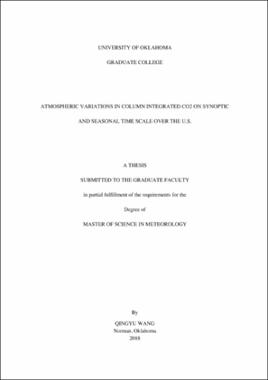| dc.description.abstract | Past studies have demonstrated that synoptic events play an important role in the spatial and temporal variations of carbon dioxide (CO2). In this study, in order to investigate whether cold fronts have impact on synoptic concentrations, we collect 83 cold frontal cases over United Sates, east Pacific Ocean and west Atlantic Ocean (or the contiguous United States: CONUS) from 2015 to 2017 with data from Orbiting Carbon Observatory-2 (OCO-2) and Modern-Era Retrospective analysis for Research and Applications, Version 2 (MERRA-2), calculate the Column-averaged carbon dioxide dry air mole fraction (XCO2) difference anomalies across the fronts, and apply significance test in each season based on non-frontal days climatology to decide whether cold fronts relate to horizontal changes. The large day-to-day variability at the same location from Weather Research and Forecasting- Vegetation Photosynthesis and Respiration Model (WRF-VPRM) suggest that randomly selected orbits which are not crossing any fronts are a better reference than monthly mean on the same spatial resolution in one month.
Seeing that OCO-2 measures well on mesoscale and synoptic scale, we regard OCO-2 data as the truth and examine whether simulations from WRF-VRPM are simulating well over the contiguous United States (CONUS). Based on land cover classifications given by the Moderate Resolution Imaging Spectroradiometer (MODIS), we compute the difference between the model simulations and OCO-2 observations for each land cover type in each season. The evaluation reveals that the model agrees well with OCO-2 for some specific land cover and season, like forests in the winter, while still relative high bias in summer for most surface types.
In summary, the result that frontal gradients have similar pattern with past studies in boundary layer demonstrates that OCO-2 is a good tool to see mesoscale or synoptic and seasonal variations over the CONUS. Accordingly, regarding OCO-2 data as the truth, outputs from WRF-VPRM are evaluated based on 7 land cover types, which was proved generally well in winter over some land cover types, but may not ideal for others. | en_US |
